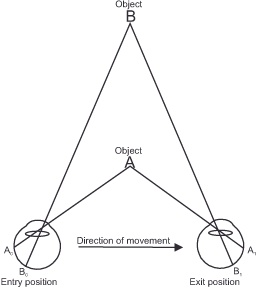You are here: Nature Science Photography – Image creation, Depth and Size – Space perception
Motion parallax serves as a cue for us to perceive spatial depth based on the relative speed between us and objects in space. This speed difference is particularly apparent when we look out the window of a moving vehicle. The objects near us, like the guardrails and boundary posts of the road, appear blurry, while those far away on the horizon move slowly. This leads to the following criterion: Objects far away move slowly; objects near us move quickly. Why it behaves in this way can be explained quite quickly if we use figure 27 (Motion Parallax) to illustrate what happens to the image on our retina during a movement.

We assume that there is a near object A, a far object B, and an eye that moves from the input position to the right and then to the output position. In the input position, A is imaged on A0 and B on B0. At the end of the movement, these retinal images shift to A1 and B1. Thus, the image of A has traveled a relatively long distance across the observer’s field of view, while the image of B has moved only slightly compared to it. Close objects, therefore, travel longer distances on the retina during a movement than more distant ones, and since the time span for both is the same, they must do this faster. This is why the difference in speed allows us to infer the distance.
Next Progressive covering and uncovering of surfaces
Main Image creation, Depth and Size
Previous Sharpness and blur
If you found this post useful and want to support the continuation of my writing without intrusive advertising, please consider supporting. Your assistance goes towards helping make the content on this website even better. If you’d like to make a one-time ‘tip’ and buy me a coffee, I have a Ko-Fi page. Your support means a lot. Thank you!


 Since I started my first website in the year 2000, I’ve written and published ten books in the German language about photographing the amazing natural wonders of the American West, the details of our visual perception and its photography-related counterparts, and tried to shed some light on the immaterial concepts of quantum and chaos. Now all this material becomes freely accessible on this dedicated English website. I hope many of you find answers and inspiration there. My books are on
Since I started my first website in the year 2000, I’ve written and published ten books in the German language about photographing the amazing natural wonders of the American West, the details of our visual perception and its photography-related counterparts, and tried to shed some light on the immaterial concepts of quantum and chaos. Now all this material becomes freely accessible on this dedicated English website. I hope many of you find answers and inspiration there. My books are on